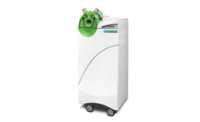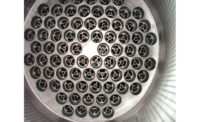By Wilhad M. Reuter, PerkinElmer
What are mycotoxins?
The worst nightmare for a dairy producer or dairy processor is to learn that one of its products made someone sick. Unfortunately, in many parts of the world, an industry that thrives on its reputation for wholesome nutritious products continues to fall victim to an age-old natural nemesis: mycotoxins.[1]
Mycotoxins, including chemically-similar aflatoxins, are secondary metabolites produced by microfungi or mold that form in and on foods, nuts, grain, soybeans and feeds that are improperly stored or exposed to moisture in temperate climates that experience varying temperatures.[2] According to The American Phytopathological Society, mycotoxins contaminate roughly 25% of the world’s food crops, resulting in the loss of one billion metric tons of food every year.
Mycotoxins are a threat to human health
The impact of these naturally occurring toxins on humans can trigger a cascade of illnesses, from liver and kidney disease (including cancer) to immunosuppression disorders, birth defects and a reduced rate of growth in children.[3] Since they pose a serious threat to humans and animals through ongoing exposure, virtually every country in the developed world has established maximum permissible levels for these compounds in food, feed and, particularly, milk.[4]
Why milk? Since researchers first discovered aflatoxins in the 1960s, they have found that milk is the primary means of introducing these compounds into the human system.[5] Aflatoxins can appear not only in raw milk, but can also be found in sterilized and pasteurized milk, yogurt, cheese, dry milk, infant formula, milk-based consumables and even breast milk, in amounts that typically range between 1 to 2%.[6] Since children consume larger amounts of cereal-based foods and milk, they face an even higher risk of exposure to mycotoxins and their effects.[7]
Impact of mycotoxins on the dairy industry
It starts with dairy cattle. A typical well-fed dairy cow can produce over 20,000 pounds of milk a year.[8] However, in order to do so, it needs to eat up to 120 pounds of wet food, or about 55 pounds of dry food, every day to sustain its body weight of between 1,200 and 2,000 pounds.
While hay and grain are the dietary staples, modern farmers favor grain because it allows their herds to produce more milk. The grain contains corn, soybeans, protein, minerals and vitamins.[9] Unfortunately, it may also contain mycotoxins, such as fumonisin B1, a known carcinogen. As cows digest contaminated grain, they excrete these mycotoxins into their milk as aflatoxin M1, and lesser amounts of M2, both known carcinogens.
Aflatoxins are particularly hardy compounds that are difficult to eradicate from milk and dairy products, even after repeated processing, including sterilization and pasteurization.[10] Worse still, they are hard to detect in small amounts without proper instrumentation and scientific expertise.
Another issue is regulatory uniformity. While the European Union has set the strictest limit of 0.05 parts per billion (ppb) for mycotoxin in milk, the U.S. limit of 0.5 ppb is significantly more tolerant .[11] In other countries, such as in South America, Africa and Asia, there are no limits at all.[12]
Methods and tests to detect mycotoxins in milk
Fortunately, several methods are now available to discover mycotoxins and aflatoxins in food, feed and milk. Bioo Scientific, a PerkinElmer company, has developed AutoFlow Aflatoxin M1 test strips treated with gold particles for rapid field and lab use in detecting the presence of the M1 toxin in milk.
While these test strip techniques are handy in testing raw cow’s milk, the preferred methods for the analysis of aflatoxin in milk remain lab-based and include enzyme-lined immunosorbent assays (ELISA), fluorescence spectrometry and high-performance liquid chromatography (HPLC). Each of these methods provides advantages and shortcomings.
ELISA is the preferred method for testing aflatoxin in cheese
PerkinElmer's bead-based AlphaLISA immunoassay technology, for example, is designed for the detection of analytes in biological samples. In tandem with the PerkinElmer Aflatoxin AlphaLISA detection kit, the technology can be used on large assay platforms, such as the PerkinElmer EnVision and VICTOR systems, that can test many samples simultaneously with remarkable sensitivity, dynamic range, or performance. It is often the preferred method for testing aflatoxin in cheese.[13]
Luminescence to detect aflatoxins
Having the ability to see molecular structures of toxins in the ultraviolet-visible region is essential to our understanding of these molecules and their composition. Using instruments such as the PerkinElmer LS-55 Luminescence Spectrometer allows labs to quantify aflatoxins emitting light at different wavelengths from 5 ppb to 500 ppb, within a few minutes. However, its use in detecting aflatoxin in milk products is limited, especially for European markets where the limits are below 5 ppb.
HPLC - the global gold analytical standard
High-performance liquid chromatography (HPLC) is the global gold standard for the separation and quantitation of organic analytes in milk.[14] Used in over 80% of organic analyses, HPLC is often employed with UV absorption, fluorescence or MS (mass spectrometry) detectors.
One such system is the PerkinElmer Altus HPLC system. When coupled with the PerkinElmer Altus A-10 fluorescence detector, this technology is the ideal solution for analytically reaching the EU’s very low control limit for afltoxin M1 in raw and processed milk - in under six minutes. Using this system, the limit of quantitation for aflatoxin is less than 0.015 ppb, making the toxin easily quantifiable down to the 0.05 ppb level established by the EU as the maximum tolerable level in milk.[15], [16]
This technology results in the best lab performance
For optimal analytical performance and maximum mycotoxin sensitivity, liquid chromatography with a TQMS (triple quadrupole mass spectrometer, or LC-MS/MS, provides the lowest limits of quantification over a large dynamic range of mycotoxins
Choose the technology that’s right for your dairy lab
Determining which technology to use depends on the level of sensitivity required and where the analysis of these toxins is expected to take place. For aflatoxin screening down to 20 ppb in the field, lateral flow test strips are a valuable tool. For sub-ppb analyses in the lab, both ELISA and HPLC can be utilized. Finally, for analyte separation performance and ppt (parts per trillion) sensitivity on multiple mycotoxins, LC-MS/MS is the go-to technology.
Wilhad M. Reuter is a Strategic LC and LC-MS Applications Specialist at PerkinElmer, having worked there for the past 32 years. He is involved in LC-related product and method development, product specialist supp
[1] FAO, “Worldwide Regulations For Mycotoxins In Food And Feed In 2003,” Food and Agriculture Organization of the United Nations, http://www.fao.org/docrep/007/y5499e/y5499e07.htm, accessed September 12, 2016
[2] Silvia W. Gratz, Neil Havis, Fiona Burnett, “Fusarium Mycotoxin Risk In The Human Food Chain,” New Food, Vol. 18, Issue 4, 2015, http://www.newfoodmagazine.com/category/new-food-magazine/past-issues/issue-4-2015/, accessed September 10, 2016.
[3] Subroto Mukherjee, “Aflatoxin Effect On Health,” USAid PowerPoint Workshop Presentation, http://www.fao.org/fileadmin/user_upload/wa_workshop/ECAfrica-caadp/4._Aflatoxin_USAID.pdf, accessed September 12, 2016.
[4] Hamid Mohammadi, “A Review of Aflatoxin M1, Milk, and Milk Products,” in Ramon Guevara-Gonzales, ed., Aflatoxins – Biochemistry and Molecular Biology (2011: InTech), http://www.intechopen.com/books/aflatoxins-biochemistry-and-molecular-biology/a-review-of-aflatoxin-m1-milk-and-milk-products, accessed September 12, 2016.
[5] Wilhad M Reuter, “Analysis Of Aflatoxins In Milk By HPLC Using Kobra Cell And Fluorescence Detection,” PerkinElmer Application Note, https://www.perkinelmer.com/lab-solutions/resources/docs/APP_01298501_Analysis_of_Aflatoxins_in_Milk_by_HPLC.pdf, accessed September 12, 2016.
[6] Ibid.
[7] Gratz, et. al., “Fusarium Mycotoxin Risk In The Human Food Chain,” op. cit.
[8] USDA, “Milk Cows and Production Final Estimates 2003-2007,” Statistical Bulletin Number 1022, March 2009, http://usda.mannlib.cornell.edu/usda/nass/SB988/sb1022.pdf, accessed September 10, 2016.
[9] Dave Fischer and Mike Hutjens, “How Many Pounds Of Feed Does A Cow Eat In A Day?,” University of Illinois - Illini DairyNET, August 13, 2007, http://articles.extension.org/pages/37808/how-many-pounds-of-feed-does-a-cow-eat-in-a-day, accessed September 10, 2016.
[10] Alex P. Wacoo, Deborah Wendiro, Peter C. Vuzi, and Joseph F. Hawumba, “Methods for Detection of Aflatoxins in Agricultural Food Crops,” Journal of Applied Chemistry, Vol. 2014, https://www.hindawi.com/journals/jac/2014/706291/, accessed September 10, 2016.
[11] USFDA, “CPG Sec. 527.400 Whole Milk, Lowfat Milk, Skim Milk - Aflatoxin M1,” USFDA Inspections, Compliance, Enforcement, and Criminal Investigations, updated March 20, 2015, http://www.fda.gov/ICECI/ComplianceManuals/CompliancePolicyGuidanceManual/ucm074482.htm, accessed September 11, 2016.
[12] FAO, “Worldwide Regulations For Mycotoxins In Food And Feed In 2003,” op. cit.
[13] Assem Elkaka, Oula El Atata, Jean Habiba, Mohamad Abbasa, “Occurrence of aflatoxin M1 in cheese processed and marketed in Lebanon,” Food Control, Vol 25, May 2012, pp. 140 – 143, http://www.sciencedirect.com/science/article/pii/S0956713511004373, accessed September 12, 2016.
[14] Ibid.
[15] Wilhad M. Reuter, “Analysis Of Aflatoxin M1 In Raw Milk By HPLC With Fluorescence Detection,” PerkinElmer Application Note, 2016, https://www.perkinelmer.com/lab-solutions/resources/docs/APP_012972_01_Analysis_of_Aflatoxin_in_Raw_Milk_by_HPLC.pdf, accessed September 9, 2016.
[16] Wilhad M. Reuter, “Analysis Of Aflatoxins In Milk By Hplc Using Kobra Cell And Fluorescence Detection,” PerkinElmer Application Note, 2016, https://www.perkinelmer.com/lab-solutions/resources/docs/APP_01298501_Analysis_of_Aflatoxins_in_Milk_by_HPLC.pdf, accessed September 9, 2016.



